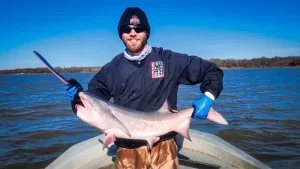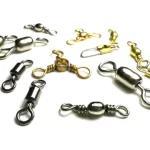Paddlefish (Polyodon spatula) are one of the most unique freshwater species in North America, known for their smooth skin, cartilage-based skeleton, and fascinating paddle-like rostrum. These large fish, sometimes called spoonbills or shovelnose catfish, have lived in the region for over 300 million years, making Paddlefish an ancient and remarkable part of North America’s aquatic ecosystem.
Identification of Paddlefish
Paddlefish are easily identifiable due to their distinctive elongated rostrum, or nose, which can extend up to 7 feet long. This “paddle” is rounded at the end and gives the fish its name. Their small eyes are located at the base of the rostrum, which faces downward and forward. Another unique feature of paddlefish is their long operculum (gill flap), which extends beyond the pectoral fins and has a spotted pattern along the side.
Unlike sharks, paddlefish have no teeth. Instead, they possess specialized gill rakers that allow them to filter-feed by extracting tiny organisms from the water. These creatures glide through the water with their large mouths open, feeding on zooplankton and other microscopic life forms.

Habitat and Range of Paddlefish
Paddlefish are primarily found in the Mississippi River basin, as well as in the Missouri River, extending northward to Montana. They thrive in large, free-flowing river systems, including braided channels, backwaters, and oxbow lakes. Paddlefish are present in 22 states, with 15 states actively stocking them in reservoirs, including Missouri, Arkansas, Illinois, and West Virginia. They are also found in the Gulf of Mexico drainage systems, from Texas to Alabama.
Despite their once vast range, paddlefish populations have been affected by overfishing, habitat loss, and the construction of dams, which block their migratory paths to historical spawning grounds. Consequently, their numbers have dwindled in some areas, and the species is now more difficult to find.
Paddlefish Spawning Process
Spring rains signal the start of paddlefish spawning. As water levels rise, paddlefish journey to their spawning habitats, where they engage in broadcast spawning. During this process, females release their eggs into the water, and males release sperm to fertilize them. The fertilized eggs settle on the substrate, where they will hatch. Once hatched, the fry are carried downstream by currents to deeper pools with slower water, where they can feed on drifting food.
Paddlefish rely on specific environmental conditions for successful spawning, such as optimal water temperature, current, and sunlight duration. These factors must align to ensure the reproductive success of the species.
Lifespan and Size of Paddlefish
Paddlefish grow rapidly during their first year, reaching lengths of 12 to 14 inches, and sometimes up to 20 inches. As they mature, their growth slows, and they typically gain about 2 inches per year after five years. By the time they reach 7 to 10 years old, they are sexually mature. Adult paddlefish can grow up to 7 feet long and weigh as much as 200 pounds. Larger fish, often females, can live to be 40 years old, while males generally have an average lifespan of 20 years.
In 2024, a world record paddlefish was caught in Kansas, weighing an impressive 164 pounds 13 ounces, surpassing the previous record and showcasing the remarkable size this species can achieve.
Feeding Habits
Paddlefish feed by filtering microscopic organisms from the water. Their unique sensory pores located along the rostrum, lower jaw, and gill covers allow them to detect electrical signals emitted by zooplankton. This advanced “radar” system helps them locate food, even if the rostrum is damaged.
Conservation Challenges
Paddlefish face several threats to their survival. Dams, which have been built for flood control and to create reservoirs, prevent paddlefish from migrating to their historical spawning grounds. This, combined with increased pollution and sedimentation, has impacted their ability to reproduce effectively.
Additionally, paddlefish have become targets for illegal poaching due to the high demand for their eggs, which are used to produce caviar. Overfishing, particularly in areas where commercial markets demand paddlefish meat and roe, has further stressed populations.
These fish, which prefer large, open waters with moderate currents, are also vulnerable to boat strikes. Since they swim near the water’s surface while feeding, fast-moving boats can easily collide with them, especially in areas with heavy boat traffic.
Paddlefish are a fascinating and ancient species that play an important role in freshwater ecosystems. While they face significant challenges due to habitat loss and overfishing, efforts to protect and preserve them are critical for maintaining the biodiversity of North America’s rivers. Their unique characteristics and history make them a captivating subject for anglers and conservationists alike.
Image/Source: Wired2Fish





